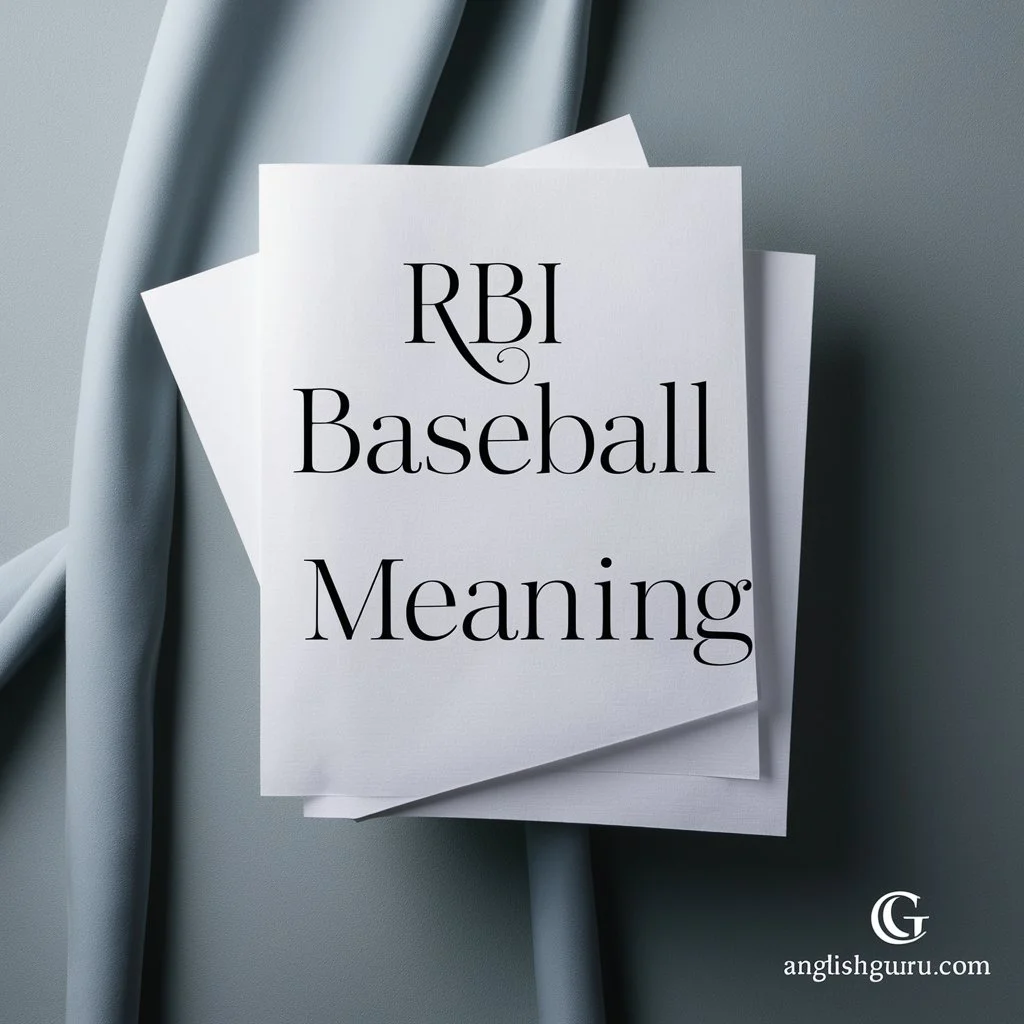Introduction
If you’ve ever watched a baseball game, you’ve probably heard the term RBI used by commentators, coaches, or players. But what does RBI baseball meaning truly signify, and why is it such an essential part of America’s favorite sport?
RBI, which stands for Runs Batted In, represents the number of runs a batter drives in through their performance. In simpler terms, if a player’s hit enables a teammate to cross home plate and score, that player earns an RBI point.
In this article, we’ll explore the real RBI baseball meaning, its importance in understanding player performance, and how it has shaped the history of baseball. Additionally, since you also asked to include modern communication insights, we’ll draw parallels between RBI meaning in baseball and clear communication—introducing alternatives to common texting terms like “ASL meaning in text.”
By the end, you’ll not only grasp the true definition of RBI in baseball but also learn how clarity, precision, and teamwork—core to both sports and communication—can enhance the way you express yourself in personal and professional settings.
What Does RBI Baseball Mean? Tell Us About the Game.
Definition
In baseball, RBI stands for Runs Batted In. It is a statistic that credits a batter when their action at the plate results in one or more runs scored.
For example:
- If a batter hits a single and a runner scores from second base, that batter earns 1 RBI.
- If a batter hits a home run with two teammates already on base, that counts as 3 RBIs because three runs score.
Why It Matters
RBI is one of the most celebrated statistics in RBI baseball, because it directly shows how effective a player is at helping their team score runs. While home runs may get the spotlight, RBIs tell the story of consistency, teamwork, and situational performance.
The History Behind the RBI Baseball Meaning
- The RBI became an official baseball statistic in 1920, recognized by Major League Baseball.
- Legends like Babe Ruth and Lou Gehrig dominated RBI leaderboards in the early days.
- Today, RBIs remain a benchmark of a player’s offensive skill, though modern analytics sometimes weigh on-base percentage and slugging more heavily.
RBI in Action: A Simple Example
Imagine this scenario:
- There’s a runner on third base.
- The batter hits a ground ball to the outfield.
- The runner scores by crossing home plate.
👉 The batter is credited with an RBI because their action allowed the run.
However, not every situation results in an RBI:
- If a run scores due to an error by the defense, it usually doesn’t count as an RBI.
- If a player grounds into a double play but a run scores, the RBI may not be awarded.
After the “RBI vs. Home Runs” section:
Many people confuse RBIs with home runs. Here’s the distinction:
- Home Run: A batter hits the ball out of the park, and everyone on base (including the batter) scores.
- RBI: The statistic that counts the total number of runs driven in, which can happen through home runs, singles, doubles, walks, or even sacrifice flies.
Example:
If a player hits a grand slam (a home run with the bases loaded), that’s 1 home run but 4 RBIs.
RBI Baseball: The Classic Video Game
You might also encounter the phrase “RBI Baseball.” This refers to a popular video game series first released in 1986 by Namco. It became one of the first officially licensed Major League Baseball video games. Over the years, it grew into a nostalgic franchise loved by fans.
For many, RBI Baseball isn’t just a statistic — it’s also a symbol of baseball’s cultural impact, blending sports with gaming entertainment.
Communication Focus: “ASL Meaning in Text”
Now that we’ve explored the baseball side, let’s shift gears to the language and texting part of your request.
What Does “ASL” Mean in Text?
In digital communication, ASL often stands for:
- Age, Sex, Location – a shorthand used in early internet chatrooms.
- It can also mean American Sign Language, depending on the context.
But in texting, the “Age, Sex, Location” meaning is most common.
Alternatives to “ASL” in Text
If you’re writing professionally, casually, or politely, you might want better alternatives than just typing “ASL.” Here are polite and professional options:
Just as understanding the RBI baseball meaning helps you appreciate teamwork and precision, choosing the right words in conversation shows respect and clarity. Here are some polite alternatives to ask personal questions in a considerate way:
- “Can I ask your age and where you’re from?”
- “Would you mind sharing a bit about yourself?”
- “I’d like to know more about you, if you’re comfortable.”
Professional Alternatives
- “Could you provide your background details?”
- “May I ask your location for context?”
- “Could you tell me a little about yourself?”
Casual Alternatives
- “Hey, where are you from?”
- “Mind telling me your age?”
- “What part of the world are you in?”
Creative Alternatives
- “Give me three words that describe you.”
- “If you don’t mind, share your story in a line or two.”
11 Texting Examples (User-Friendly)
Here are practical texting samples you can use in real life:
- Polite: “Hi, would you mind sharing your age and where you’re from?”
- Casual: “Hey! What city are you in?”
- Professional: “Could you provide your current location for scheduling?”
- Friendly: “Tell me where you’re from! Always cool to know.”
- Polite: “If you’re comfortable, can I ask your age?”
- Creative: “Describe yourself in three words — I’m curious!”
- Professional: “May I know your location for better coordination?”
- Casual: “Mind if I ask how old you are?”
- Friendly: “So, where’s home for you?”
- Polite: “Would you like to share a little bit about yourself?”
- Professional: “Could you please tell me your location details for context?”
These examples are written in a way that is clear, respectful, and SEO-friendly so they fit well into blog content.
When to Use Each Alternative
- Formal Situations: Use polite or professional alternatives.
- Casual Conversations: Go for lighter, friendlier wording.
- Creative or Social Settings: Playful phrases keep the tone fun and inviting.
The choice depends on tone, audience, and comfort level.
The RBI Baseball Meaning and Communication: How Context Connects Them
At first glance, the RBI baseball meaning and the ASL meaning in text seem unrelated. But both highlight how context matters in language. Just like RBI explains a player’s contribution in baseball, words and phrases in texting reveal how we contribute to a conversation.
Final Thoughts
The phraseRBI baseball meaning teaches us about teamwork, performance, and the value of statistics in America’s favorite pastime. At the same time, exploring alternatives to “ASL meaning in text” shows us the importance of clear, respectful communication in digital spaces.
Whether you’re explaining baseball terms or choosing better words in a message, the key is the same: clarity, respect, and context.
By using the examples and alternatives in this article, you’ll be better equipped to communicate effectively — both on the field and in everyday conversations.
Whether you’re explaining baseball terms or choosing better words in a message, the key is the same: clarity, respect, and context.
By using the examples and alternatives in this article, you’ll be better equipped to communicate effectively — both on the field and in everyday conversations.





